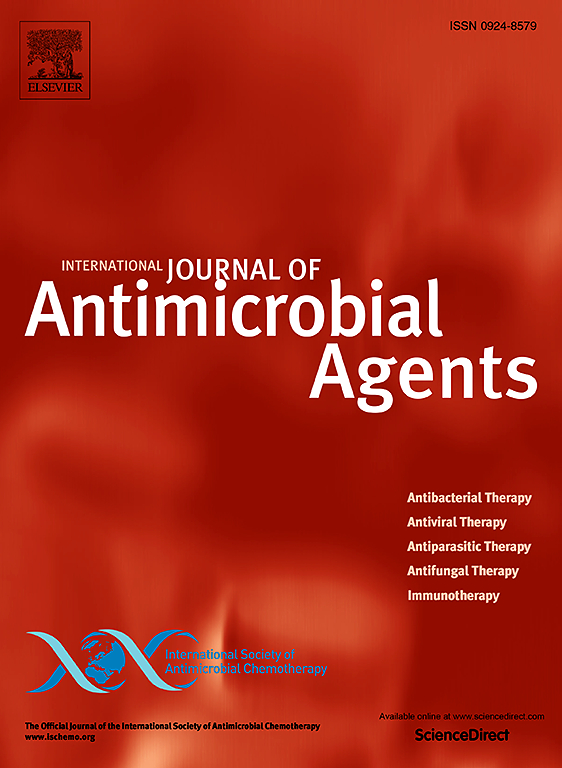Comparison of population pharmacokinetic modeling and machine learning approaches for predicting voriconazole trough concentrations in critically ill patients
IF 4.9
2区 医学
Q1 INFECTIOUS DISEASES
International Journal of Antimicrobial Agents
Pub Date : 2025-02-01
DOI:10.1016/j.ijantimicag.2024.107424
引用次数: 0
Abstract
Background
Despite the widespread use of voriconazole in antifungal treatment, its high pharmacokinetic and pharmacodynamic variability may lead to suboptimal efficacy, especially in intensive care unit (ICU) patients. Machine learning (ML), an artificial intelligence modeling approach, is increasingly being applied to personalized medicine. The effectiveness of ML models for predicting voriconazole blood concentrations in ICU patients, compared to traditional population pharmacokinetics (popPK) models, has been uncertain until now. This study aims to identify the most effective modeling strategy for voriconazole.
Methods
We developed six ML models using 244 concentrations from 62 patients in our previous popPK dataset. Another additional dataset, consisting of 282 trough concentrations from 177 patients, was used to externally evaluate both ML models and five other published popPK models, utilizing prediction-based diagnostics, simulation-based diagnostics, and Bayesian forecasting.
Results
The XGBoost model exhibited superior predictive performance among the six ML models, achieving an R2 of 0.73. Its performance metrics (RMSE%: 127.21 %, median absolute prediction error: 29.65 %, median prediction error: 9.82 %, F20: 34.04 %, F30: 50.71 %) outperformed those of the best popPK model (RMSE%: 152.41 %, median absolute prediction error: 44.75 %, median prediction error: −0.99 %, F20: 23.40 %, F30: 36.88 %), suggesting greater accuracy and precision in predicting pharmacokinetics.
Conclusions
Both ML and popPK models can be utilized for individualized voriconazole therapy. Our comparative study provides insights into the most effective methods for modeling and predicting voriconazole concentrations.
危重病人群体药代动力学模型与机器学习方法预测伏立康唑谷浓度的比较。
尽管伏立康唑广泛用于抗真菌治疗,但其高药代动力学和药效学变异性可能导致疗效不佳,特别是在重症监护病房(ICU)患者中。机器学习(ML)是一种人工智能建模方法,越来越多地应用于个性化医疗。与传统的人群药代动力学(popPK)模型相比,ML模型预测ICU患者伏立康唑血药浓度的有效性至今仍不确定。本研究旨在确定伏立康唑最有效的建模策略。我们使用先前popPK数据集中来自62名患者的244种浓度开发了6个ML模型。另一个额外的数据集,包括来自177名患者的282个谷浓度,用于外部评估ML模型和其他5个已发表的popPK模型,利用基于预测的诊断、基于模拟的诊断和贝叶斯预测。结果表明,XGBoost模型在6种ML模型中具有较好的预测性能,R2为0.73。其性能指标(RMSE%: 127.21%,中位数绝对预测误差:29.65%,中位数预测误差:9.82%,F20: 34.04%, F30: 50.71%)优于最佳popPK模型(RMSE%: 152.41%,中位数绝对预测误差:44.75%,中位数预测误差:-0.99%,F20: 23.40%, F30: 36.88%),表明其预测药代动力学的准确性和精密度更高。综上所述,ML和popPK模型均可用于伏立康唑个体化治疗。我们的比较研究为建模和预测伏立康唑浓度提供了最有效的方法。
本文章由计算机程序翻译,如有差异,请以英文原文为准。
求助全文
约1分钟内获得全文
求助全文
来源期刊
CiteScore
21.60
自引率
0.90%
发文量
176
审稿时长
36 days
期刊介绍:
The International Journal of Antimicrobial Agents is a peer-reviewed publication offering comprehensive and current reference information on the physical, pharmacological, in vitro, and clinical properties of individual antimicrobial agents, covering antiviral, antiparasitic, antibacterial, and antifungal agents. The journal not only communicates new trends and developments through authoritative review articles but also addresses the critical issue of antimicrobial resistance, both in hospital and community settings. Published content includes solicited reviews by leading experts and high-quality original research papers in the specified fields.

 求助内容:
求助内容: 应助结果提醒方式:
应助结果提醒方式:


